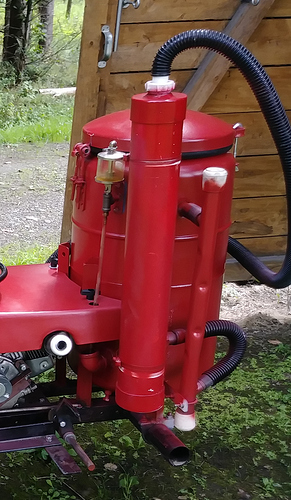Ahh, thanks guys for straightening me back out. Looks like I had a solution in search of a problem 
I don’t want to divert you from your noble gasifier quest, but if you live in a cold climate you need heat in your shop.
Rindert
Thanks Rindert! I love permies.com and those types of heaters. I have a relatively large greenhouse that I’m hoping to heat with compost but if that fails, I’m dreaming about a charcoal generating batch box heater of some sort.
I should have been a bit more clear about my needs though. First I need a shop  , THEN I need some time or heat. If I have heat I can work in the winter when I have more time.
, THEN I need some time or heat. If I have heat I can work in the winter when I have more time.
You’re going to end being like Wayne. He built a bulldozer, a sawmill, a house, … and finally a bunch of gasification stuff. ![]() But hey! Nothin wrong with that at all.
But hey! Nothin wrong with that at all.
Rindert
I have never seen a gradual taper as you describe, probably just because of the technical challenge of building it that way. Here is a design that Koen in Thailand came up with
Gilmore style? - #1019 by k_vanlooken
I think his bottom reactor tubes are only 5 or 6 inches in diameter. His nozzle points upwards, so that helps prevent a hot spot forming on the opposite side. I have always really wanted to build something in that configuration, but I have never been able to find a good thin-walled tube in that dimension.
As others noted an inline blower isnt needed, but If you look around, there are people that have done it with the bigger bilge blowers. I have never really had a problem with getting the char-gas close enough to the intake. Your engine is displacing a lot of gas with each pull, and you can get rich gas through a couple feet of hose in 2 or 3 pulls.
This depends on how you orient your nozzle. A lot of guys now run the air in vertically, instead of straight through the side. My first design basically just had a hole in the bottom of the reactor, and every hiccup in the engine would scatter some burning coals on the ground. Using a leitinger nozzle really eliminates that problem, as anything that falls down stays in the tube. A fine wire mesh cap would also help. Some designs use a nozzle over an ash-pit, but then you need to have some arrangement to light it up at the start.
Cooling large quantities of charcoal in a sealed barrel is a very bad idea. the vacuum it creates is capable of crushing a 55 gallon drum, or at least clamping the lid on so tight you have to drill or smash it open. In hindsight, drilling a hole would have been better than just hammering on the rim out of frustration - so learn from my mistake if you ever do that ![]() it was a brand new barrel too. Shouldnt be a problem with the gasifier, though, it will find some tiny little leak to equalize the pressure as it cools off.
it was a brand new barrel too. Shouldnt be a problem with the gasifier, though, it will find some tiny little leak to equalize the pressure as it cools off.
I am in a similar situation, in that I need to build a shop before I can get too much more done on my woodgas setup. Hopefully it will stop raining soon…
Thanks Carl! That Gilmore design is along the lines of what I was thinking. How thin is ideal for the small tube? Would an insulated 6" stove pipe be too thin? Can the tube be too thick? I’m imagining an old oxy or acetylene tank…
So if I went with a Leitinger nozzle it would have the effect of a vertical nozzle so then I could go with the Gilmore style small lower tube and also not have grass fires?
Hello Mike
Acetylene tank is full of stuff ! Don’t ask me how I know .
Yes, what Wayne said about the Acetylene tank, and a high-pressure tank like oxygen would work, but is way heavier (thicker steel) than you need for a charcoal gasifier.
Gotcha, so I have the geometry/shape correct, just need to stumble upon the right tank or tube (that isn’t acetylene related). Thanks!
Koen likes using irrigation tubing, apparently fairly thin wall. I’m sure a scrap yard, or a steel yard could set a guy up, either way, for the length needed it will be pretty reasonable.
Obtanium is sweet, but sometimes it’s best to just get what is specified, and get building… 
Hi Mike , don’t go as low as 6 inch pipe it would need to be so tall to get any sort of decent run time out of it , the best all round size i have found to be 12 or 14 inch dia , that gives plenty of room to cool the outside and also get a decent run time for a hight of around 30 inches .
I would look for something like an old propane tank around the hight you can manage , just make sure its been well washed out and maybe filled with water before you start cutting holes in it .
Dave
Thanks Dave, I’d only go 6-8" if I was doing the Gilmore design. If it was a consistent diameter the whole way I’d aim for 12-14" or a propane tank.
I’ll definitely check out the junk yard when this project approaches, thanks Garry!
When I build one, I’m going to use a used pressure tank I got from a local well company for free. You can get big and small ones.
Be careful if using torch, or plasma to cut these they have rubber bladders inside, nasty fumes.
No problem, I’ll be careful with whatever I find. I haven’t played with engines enough so this whole project should be good practice for me.
How hard is it to keep the tractor runable on gasoline and chargas?
Hi Mike. It can be done, be careful running chargas through cheap carburetors. The pot metal they make them out of I think is a mix of zink and aluminum mostly, and char gas will corrode them, at least it messed mine up. The butterfly vales on mine still stick sometimes even after coating the inside of the carburetor with anti-seize. Jakob
Bill, I really like those as you can see below.
Just the right gauge. Good material, placidity wise. For example the gas outlet pipe passes through the whole tank and just forms around the pipe. No adapters used. I cold cut the tank and had no problem with the bladder then cut the ring that was holding it in place. That way I kept the bladder for the future. The top got wavy but no problem with an inter tube lid seal.
I plan to reuse this one for the fuel hopper on the Buick. These are hard to find, for me.
EDIT: after years of use I never had any known carb corrosion.
Thanks Billy! Now I’m going to make some statements and ask some questions that really reveal how little I know about this. Please be kind 
So if I’m just hooking up charcoal gas to my garden tractor, I believe I’d remove the carburetor and just pipe the gas and air straight into the engine. Did I get that correct?
And if I want to be able to run gasoline in a pinch, I’d leave the carburetor on and plumb the chargas and air into the air hole on the carb and cap off the gas hole or put a small valve on it? And then hope it’s a high quality carb that won’t corrode.
Then if/when I did want to run gasoline I’d just hook up the gas line to the carb, close the chargas valve and open the air valve fully?
It is always easier to use the original carb in some way. Most leave the carb on and add a tee on the air inlet of the carb with a mixture control valve on the air intake (least resistance). Myself, the carb gets modified into a dedicated gas (not gasoline) carb.
How do you modify the carb into a dedicated woodgas carb?
Are there any build threads out there showing the details of modifying or connecting to a carb?


